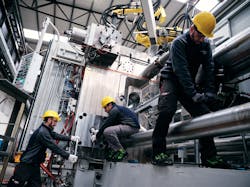Making All the Right Connections
Production systems are growing obsolete at an increasing rate thanks to operators’ and plant managers’ wider expectations of what must production systems must accomplish. Any standard evaluation of plant performance calls for a wider, deeper, and farther vision of what systems must optimally achieve. Diecasting machinery, for example, must operate not only with speed precision, and flexibility: such a system has to coordinate with now-standard Industrial Internet of Things protocols.
For Siemens AG, the realization started with a reevaluation of how space is used at its manufacturing operation in Bad Neustadt, Germany, and the conclusion that a diecasting process for electric motor component parts would have to be relocated. A project team was given a new building in which to redesign the production process.
“We very much wanted a complete solution, an all-inclusive package,” recalled Siemens’ Volker Ress, the project leader. “At the same time we had some pretty exacting specifications for the (diecasting) equipment manufacturer. For example, we wanted the robot, trimming press, and furnace supplied from specific brands. That alone required additional integration efforts that not every supplier is willing or able to make. On top of this, the new solution had to be compatible with our own IIoT operating system — MindSphere — and would, wherever possible, use Siemens components – electric motors, for example.”
MindSphere is the open operating system that networks machinery, processes, systems, plants, as well as products, for collecting and “harnessing” data generated by the IIoT using advanced cloud-based analytic functions.
An order was placed with Italpresse Gauss for two new, fully automated diecasting cells to be installed as the core of the new operation. The diecasting tooling for the production program narrowed the choice to a three-platen cold-chamber diecasting system.
Siemens chose two Italpresse machines, IP 750 SC and IP 550, with a closing force of 750 and 550 metric tons, respectively. These were fully automated cells, including robot, feed device, sprayer, immersion cooling basin, trimming press and dosing furnace. Both new cells were delivered on schedule as turnkey units in autumn 2018, and started up just a few weeks later. Since then, the two machines have been operating in a three-shift production program.
While the Siemens team chose the IP machines to produce electric motor parts, the design is well-suited to other high-volume product series, including automotive engine blocks, gearboxes, oil sumps, engine supports, and various automotive structural parts. The same systems are in use to produce parts for appliances and machinery, and telecom and electronic components, too.
For Siemens, engineering and integrating the two production cells, and defining all the interfaces, required a complete concept, one that would work seamlessly, even when integrating special requests and specifications. “Ultimately, we want a solution that is ready to go and a folder that tells us everything we need to know to run it,” according to Ress.
The ability to connect to MindSphere was particularly important. For Siemens, the diecasting machine controls had to be available to expand to process new demands for data collection, and for local IIoT integration, for example via sufficient internal memory.
“Openness, both technical and organizational, is critical,” Ress explained. “The equipment manufacturer has to be happy for us to plug an ethernet cable into the machine and grab data straight from the PLC. I need a system that gives me data relevant to the diecasting process,” he added.
The dedicated HMe control platform offers real-time storage and analysis of machine and process data, as well as data integration with peripheral and mobile devices. It is Windows-based, easy to install and with embedded connectivity, including the use of Cloud computing and storage. The user interface presents critical machine and process data in dashboards that are understandable and accessible.
“Flexibility in the specification of diecasting cells is becoming more and more important,” observed Italpresse’s Marco Giegold. “Aluminum foundries have their individual, specific requirements and increasingly they are asked to integrate these cells into sophisticated production systems.
“In this context, Industry 4.0 is only one aspect – albeit an important one,” he continued. “The more open we are to unusual customer requests, the more technologies and components we get to see and know. It allows us to constantly expand our knowledge and find the best solutions for our customers faster.”

